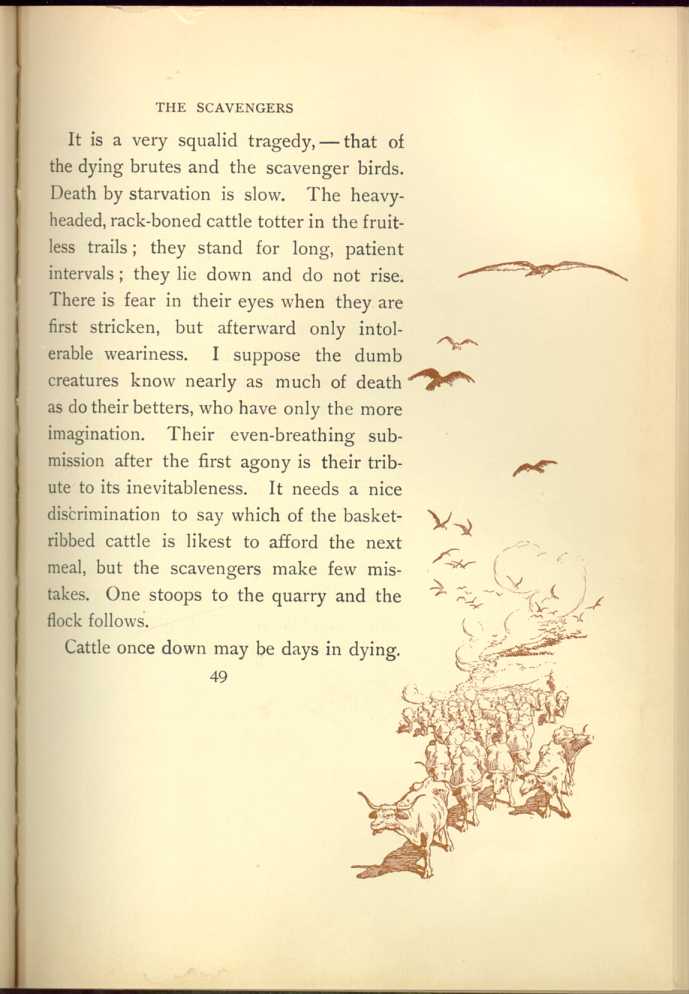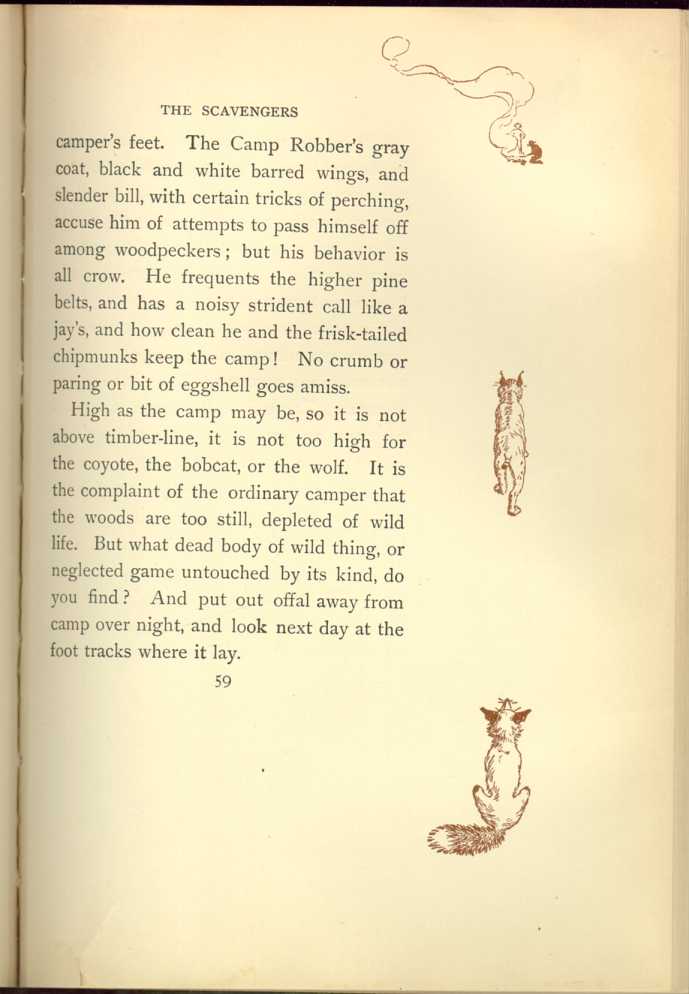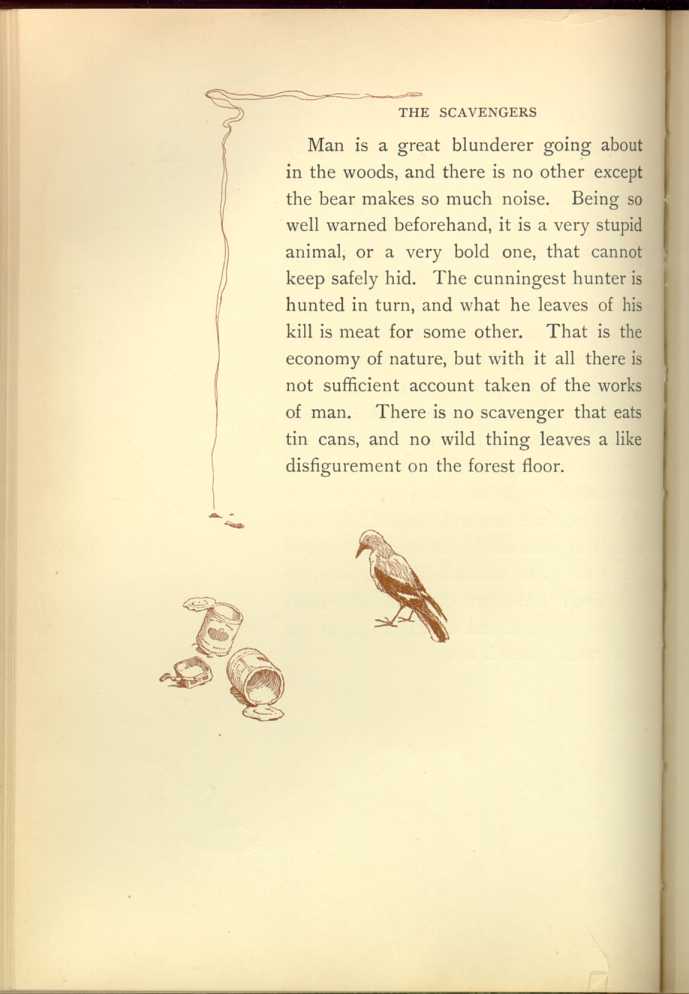|
THE SCAVENGERS The Land of Little Rain | ||
3. THE SCAVENGERS
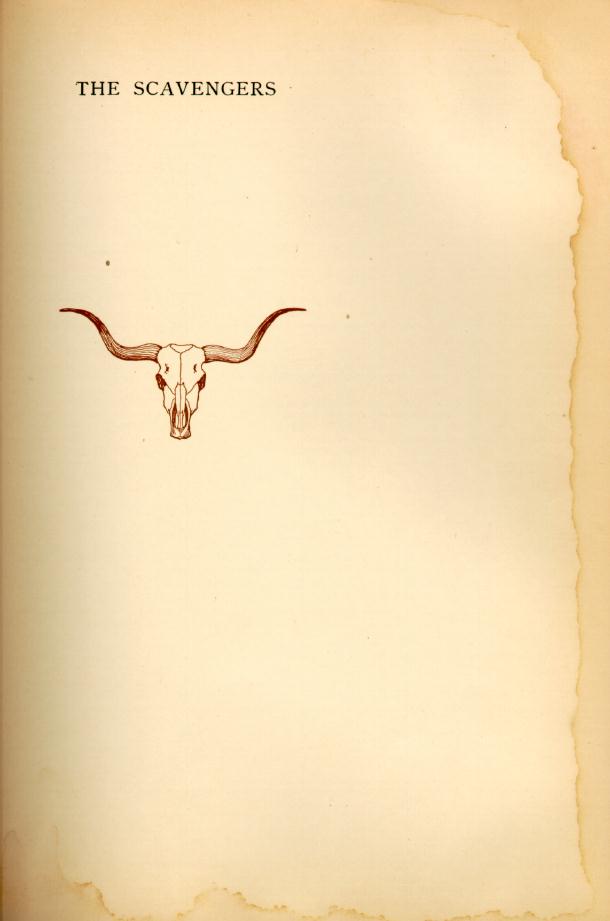 [Description:
Section Title, Chapter 3. The upper-case text at flush top left
reads, "The scavengers". Directly beneath it at center left is a
brown-toned line-drawing of a steer's skull, complete with horns,
drawn from the front. ]
[Description:
Section Title, Chapter 3. The upper-case text at flush top left
reads, "The scavengers". Directly beneath it at center left is a
brown-toned line-drawing of a steer's skull, complete with horns,
drawn from the front. ]
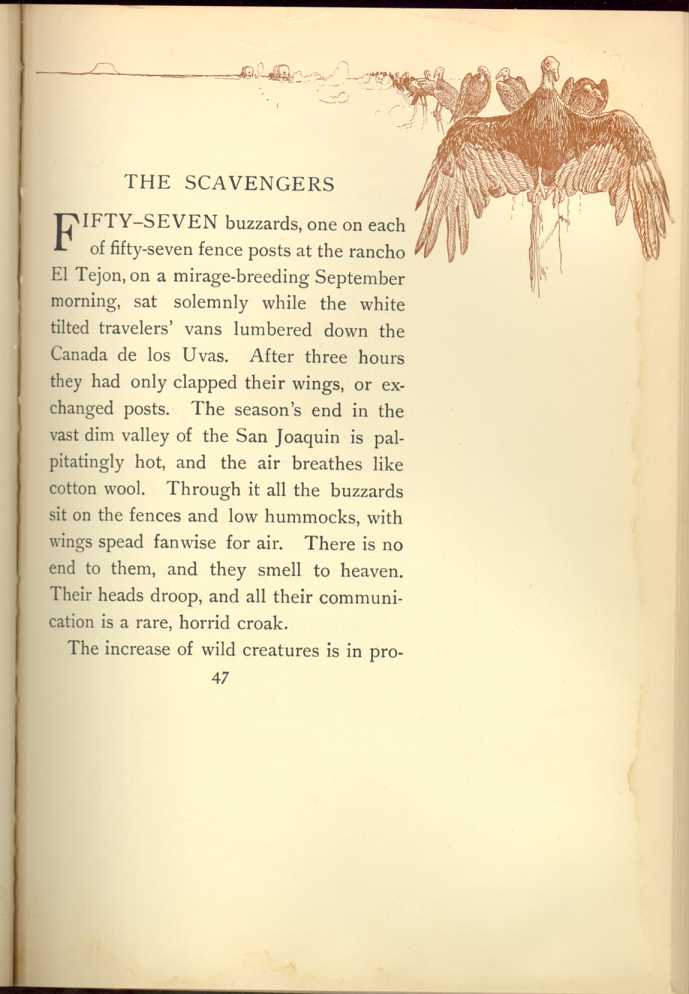 [Description:
A brown-toned line-drawing of the fifty-seven buzzards who are the
subject of the chapter's opening. The birds extend in a line from
the top right of the page into the distance over the text. The
first buzzard is shown sitting on a post, facing the viewer
directly. The buzzards further back are also on posts, often in
silhouette either left or right. Clouds of dust, two covered
wagons, and a flat-topped mountain can be seen in the left
distance. ]
[Description:
A brown-toned line-drawing of the fifty-seven buzzards who are the
subject of the chapter's opening. The birds extend in a line from
the top right of the page into the distance over the text. The
first buzzard is shown sitting on a post, facing the viewer
directly. The buzzards further back are also on posts, often in
silhouette either left or right. Clouds of dust, two covered
wagons, and a flat-topped mountain can be seen in the left
distance. ]
Fifty-seven buzzards, one on each of fifty-seven fence posts at the rancho El Tejon, on a mirage-breeding September morning, sat solemnly while the white tilted travelers' vans lumbered down the Canada de los Uvas. After three hours they had only clapped their wings, or exchanged posts. The season's end in the vast dim valley of the San Joaquin is palpitatingly hot, and the air breathes like cotton wool. Through it all the buzzards sit on the fences and low hummocks, with wings spread fanwise for air. There is no end to them, and they smell to heaven. Their heads droop, and all their communication is a rare, horrid croak.
The increase of wild creatures is in proportion to the things they feed upon: the more carrion the more buzzards. The end of the third successive dry year bred them beyond belief. The first year quail mated sparingly; the second year the wild oats matured no seed; the third, cattle died in their tracks with their heads towards the stopped water
It is a very squalid tragedy,—that of the dying brutes and the scavenger birds. Death by starvation is slow. The heavy-headed, rack-boned cattle totter in the fruitless trails; they stand for long, patient intervals; they lie down and do not rise. There is fear in their eyes when they are first stricken, but afterward only intolerable weariness. I suppose the dumb creatures know nearly as much of death as do their betters, who have only the more imagination. Their even-breathing submission after the first agony is their tribute to its inevitableness. It needs a nice discrimination to say which of the basket-ribbed cattle is likest to afford the next meal, but the scavengers make few mistakes. One stoops to the quarry and the flock follows.
Cattle once down may be days in dying. They stretch out their necks along the ground, and roll up their slow eyes at longer intervals. The buzzards have all the time, and no beak is dropped or
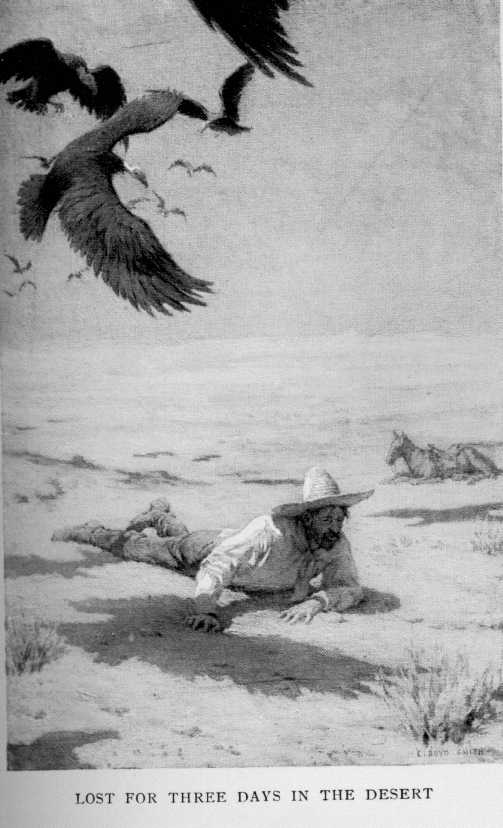 [Description:
Caption: "Lost for Three Days in the Desert." A black and white
reproduction of perhaps a watercolor of Timmie O'Shea lying on his
stomach in the desert. He wears a sombrero, a white shirt, a
necktie, and dark pants. He is trying to raise himself from the
desert floor by resting on his left elbow and pushing down on the
dirt with his right hand. His horse is in the right centerground.
Birds of prey circle overhead, casting their shadows over the man.
]
[Description:
Caption: "Lost for Three Days in the Desert." A black and white
reproduction of perhaps a watercolor of Timmie O'Shea lying on his
stomach in the desert. He wears a sombrero, a white shirt, a
necktie, and dark pants. He is trying to raise himself from the
desert floor by resting on his left elbow and pushing down on the
dirt with his right hand. His horse is in the right centerground.
Birds of prey circle overhead, casting their shadows over the man.
]
There are three kinds of noises buzzards make,—it is impossible to call them notes,—raucous and elemental. There is a short croak of alarm, and the same syllable in a modified tone to serve all the purposes of ordinary conversation. The old birds make a kind of throaty chuckling to their young, but if they have any love song I have not heard it. The young yawp in the nest a little, with more breath than noise. It is seldom one finds a buzzard's nest, seldom that grown-ups find a nest of any sort; it is only children to whom these
It is probable that the buzzard is gregarious, but it seems unlikely from the small number of young noted at any time that every female incubates each year. The young birds are easily distinguished by their size when feeding, and high up in air by the worn primaries of the older birds. It is when the young go out of the nest on their first foraging that the parents, full of a crass and simple pride, make their indescribable chucklings of gobbling, gluttonous delight. The little ones would be amusing as they tug and tussle, if one could forget what it is they feed upon.
One never comes any nearer to the vulture's nest or nestlings than hearsay. They keep to the southerly Sierras, and are bold enough, it seems, to do killing on their own account when no carrion is at hand. They dog the shepherd from camp to camp, the hunter home from the hill, and will even carry away offal from under his hand.
The vulture merits respect for his bigness and for his bandit airs, but he is a sombre bird, with none of the buzzard's frank satisfaction in his offensiveness.
The least objectionable of the inland scavengers
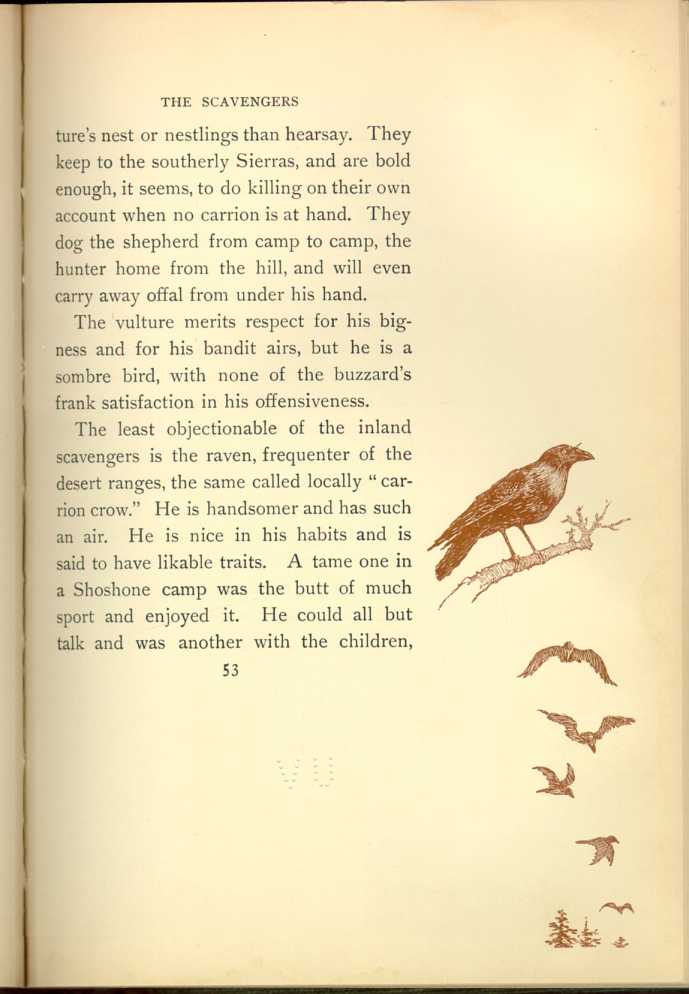 [Description:
A brown-toned line-drawing of a raven perched on a branch. The bird
is in right profile and appears to be looking at the viewer.
Beneath the perched raven is a line of silhouettes of possibly other
ravens, which descends to the bottom right corner of the page, where
the tops of evergreens also appear.
]
[Description:
A brown-toned line-drawing of a raven perched on a branch. The bird
is in right profile and appears to be looking at the viewer.
Beneath the perched raven is a line of silhouettes of possibly other
ravens, which descends to the bottom right corner of the page, where
the tops of evergreens also appear.
]
And never a coyote comes out of his lair for killing, in the country of the carrion crows, but looks up first to see where they may be gathering. It is a sufficient occupation for a windy morning, on the lineless, level mesa, to watch the pair of them eying each other furtively, with a tolerable assumption of unconcern, but no doubt with a certain amount of good understanding about it. Once at Red Rock, in a year of green pasture, which is a bad time for the scavengers, we saw two buzzards, five ravens, and a coyote feeding on the same carrion, and only the coyote seemed ashamed of the company.
Probably we never fully credit the interdependence of wild creatures, and their cognizance of the affairs of their own kind. When the five coyotes
So wide is the range of the scavengers that it is never safe to say, eyewitness to the contrary, that there are few or many in such a place. Where the carrion is, there will the buzzards be gathered together, and in three days' journey you will not sight another one. The way up from Mojave to Red Butte is all desertness, affording no pasture and scarcely a rill of water. In a year of little rain in the south, flocks and herds were driven to the number of thousands along this road to the perennial pastures of the high ranges. It is a long, slow trail, ankle deep in bitter dust that gets up in the slow wind and moves along the backs of the crawling cattle. In the worst of times one in three
The coyote is not a scavenger by choice, preferring his own kill, but being on the whole a lazy dog, is apt to fall into carrion eating because it is easier. The red fox and bobcat, a little pressed by hunger, will eat of any other animal's kill, but will not ordinarily touch what dies of itself, and are exceedingly shy of food that has been man-handled.
Very clean and handsome, quite belying his relationship in appearance, is Clark's crow, that scavenger and plunderer of mountain camps. It is permissible to call him by his common name, "Camp Robber:" he has earned it. Not content with refuse, he pecks open meal sacks, filches whole potatoes, is a gormand for bacon, drills holes in packing cases, and is daunted by nothing short of tin. All the while he does not neglect to vituperate the chipmunks and sparrows that whisk
High as the camp may be, so it is not above timberline, it is not too high for the coyote, the bobcat, or the wolf. It is the complaint of the ordinary camper that the woods are too still, depleted of wild life. But what dead body of wild thing, or neglected game untouched by its kind, do you find? And put out offal away from camp over night, and look next day at the foot tracks where it lay.
Man is a great blunderer going about in the woods, and there is no other except the bear makes so much noise. Being so well warned beforehand, it is a very stupid animal, or a very bold one, that cannot keep safely hid. The cunningest hunter is hunted in turn, and what he leaves of his kill is meat for some other. That is the economy of nature, but with it all there is not sufficient account taken of the works of man. There is no scavenger that eats tin cans, and no wild thing leaves a like disfigurement on the forest floor.
|
THE SCAVENGERS The Land of Little Rain | ||
